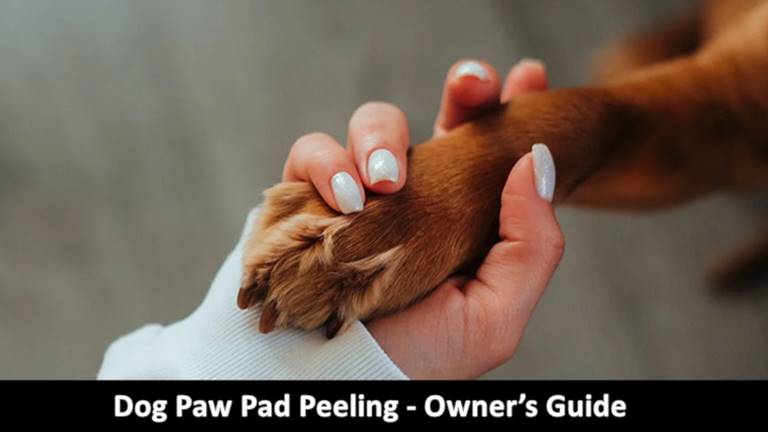As a dog owner, it is essential to keep an eye on your dog’s health and wellbeing. One common issue that dogs may experience is paw pad peeling. This condition can be uncomfortable and painful for your furry friend, and it’s important to understand the causes and treatments.
Causes of Dog Paw Pad Peeling
There are several reasons behind this condition. Below We will discuss some of the common causes of peeling paw pads, so you can better understand the issue and take the necessary steps to keep your dog healthy and happy.
1. Allergies
Allergies are one of the common causes in this condition. Allergic reactions can occur due to several reasons such as environmental factors, food, and certain medications. When a dog’s immune system reacts to these allergens, it causes irritation and inflammation in the paw pads, leading to peeling. Symptoms of allergies in dogs may also include itching, redness, and swelling in other parts of the body.
2. Dryness
Just like humans, dogs’ skin can become dry, which can cause peeling of the paw pads. Dryness in the paw pads can occur due to several reasons such as lack of hydration, dry weather, and exposure to chemicals. Dogs who spend a lot of time outside in dry weather may experience dryness in their paw pads, leading to peeling. To prevent this, it is important to keep your dog hydrated, especially during hot weather. Applying a paw pad moisturizer or balm can also help to prevent dryness and peeling.
3. Infections
Fungal or bacterial infections can cause peeling of the paw pads, especially if left untreated. The common signs of infection include redness, swelling, and itching. Dogs who spend time in damp and humid environments are more prone to developing paw pad infections. It is important to seek veterinary treatment if your dog is exhibiting these symptoms to avoid further complications.
4. Injury
Trauma to the paw pads, such as cuts or burns, can cause peeling. Dogs who spend time on rough or sharp surfaces may develop injuries, leading to peeling. It is important to keep your dog away from sharp objects and to inspect their paws regularly for any signs of injury. Applying a protective balm or booties can also help to prevent injuries and peeling.
5. Environmental factors
Walking on hot pavement or rough surfaces can cause wear and tear on the paw pads, leading to peeling. Dogs who spend a lot of time on hot pavement or rough surfaces may develop calluses or blisters on their paw pads, leading to peeling. To prevent this, it is important to avoid walking your dog on hot pavement during hot weather, and to provide protective booties if necessary.
How to Treat Dog Paw Pad Peeling at Home
If your dog is experiencing paw pad peeling, there are several things you can do at home to help treat the condition. However, it’s important to note that if the peeling is severe or accompanied by other symptoms, it’s always best to consult with a veterinarian to rule out any underlying medical conditions. Here are some home remedies for treating dog paw pad peeling.
Soak the Paws in Epsom Salt
Soaking your dog’s paws in Epsom salt can help to reduce inflammation and soothe the skin. Epsom salt contains magnesium, which is known to have anti-inflammatory properties. To use this method, add a handful of Epsom salt to a bowl of warm water and soak your dog’s paws for 10-15 minutes. Make sure the water is not too hot, as this can be uncomfortable for your dog. Repeat this process every day or every other day until the peeling subsides.
Clean Your Dog’s Paws
Keeping the paw pads clean is essential to prevent infections. Use a paw wipe or warm washcloth to clean them off before applying any bandages.
Apply a Paw Balm or Moisturizer
Choose a paw balm or moisturizer made specifically for dogs with natural ingredients. Apply it to your dog’s paw pads after they have been soaked and dried or before going outside. This will help to keep the paw pads hydrated and prevent further peeling.
Protect the Paw Pad with a Bandage
To prevent further damage and to promote healing, bandage the affected paw pad. Use pet-safe antiseptic and gauze to wrap the paw securely. Make sure to change the bandage frequently to keep the area clean and prevent infection.
Apply a Topical Treatment for Healing
Consult with a vet before using any medical ointments on your dog’s paw pad. If you prefer natural remedies, try using a natural paw balm or paw wax. Natural Dog Company’s Organic Paw Soother is a great option that contains soothing ingredients. Apply the balm or wax to the affected paw pad regularly to promote healing and prevent further damage.
6 Tips to Prevent Dog Paw Pad Peeling
Our furry friends’ paws are tough, but they are still susceptible to damage. Here are some simple tips to keep your dog’s paw pads healthy and prevent them from peeling.
1. Avoid Hot Pavement
One way to do this is to avoid walking your dog on hot pavement or surfaces, as this can quickly burn their paw pads. Instead, opt for grassy areas or walk them early in the morning or late in the evening when the pavement is cooler.
2. Keep them Clean
Another way to keep your dog’s paw pads healthy is to keep them clean. Your dog’s feet come in contact with a lot of dirt and debris, which can cause irritation and infection. Regularly cleaning their paws with a damp cloth can help remove any dirt or debris that could lead to paw pad peeling.
3. Provide Soft Surfaces
Providing soft surfaces for your dog to walk on can also help prevent paw pad peeling. Rough or abrasive surfaces like gravel or concrete can cause damage to your dog’s paw pads. Providing your dog with soft surfaces like grass, sand, or dirt can help protect their paws from injury.
4. Use Paw Protection
If your dog is prone to injuries, using protective booties or socks can be a great solution. These can help protect your dog’s paws from rough surfaces and prevent paw pad peeling.
5. Moisturize Dog Paws
Keeping your dog’s paw pads moisturized is also important for maintaining healthy paws. Use a paw balm or moisturizer specifically designed for dogs to help keep their paw pads soft and supple. This can help prevent paw pad peeling and keep your dog comfortable.
6. Keep Them Hydrated
Finally, make sure your dog has access to plenty of fresh water to keep their skin hydrated from the inside out. Dehydration can cause dry skin and paw pad peeling, so it’s important to keep your dog hydrated. With these simple steps, you can help keep your dog’s paw pads healthy and happy.


